Computex 2006: 300W GPUs, Conroe, HDMI Video Cards and Lots of Motherboards
by Anand Lal Shimpi on June 5, 2006 10:24 PM EST- Posted in
- Trade Shows
ASUS' Socket-F and Woodcrest Server Platforms
ASUS' server division was in full force showing off new platforms for both AMD and Intel servers. While ASUS' desktop shipments are approximately 32% AMD and 68% Intel, its server shipments are 40% AMD and 60% Intel reflecting the market appreciation for Opteron.
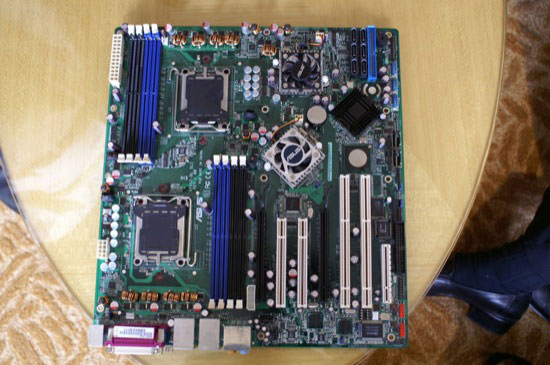 |
| Click to enlarge |
Although all we've talked about lately is AMD's desktop DDR2 platform, Socket-AM2, the server equivalent is only about a month away. Because of the very high pin count (1207 pins), AMD's DDR2 server platform, Socket-F, moved to a LGA style socket similar to what Intel has been using on the desktop since Prescott.
This Socket-F motherboard uses NVIDIA's MCP55 Professional chipset, the server/workstation version of the nForce 590 SLI desktop chipset. The MCP55 + IO55 setup results in two x16 PCIe slots that can be used for a pair of Quadro cards running in SLI mode.
The motherboard also features two mini-SAS connectors, that each can provide four SAS/SATA connectors using a 1-to-4 splitter cable.
Given the server focus of this motherboard, finding two PCI-X slots on board isn't out of the ordinary at all. The Intel PCIe to PCI-X bridge underneath the blurry black heatsink at the top of this picture drives the two PCI-X slots. Who would've expected an AMD server board with a NVIDIA chipset and an Intel PCI-X controller.
ASUS told us that it is working on a passively cooled version of this motherboard that may be ready by the time it ships.
Next up is ASUS' Blackford motherboard for the Xeon platform. Intel's Blackford chipset supports Woodcrest as well as FB-DIMMs.
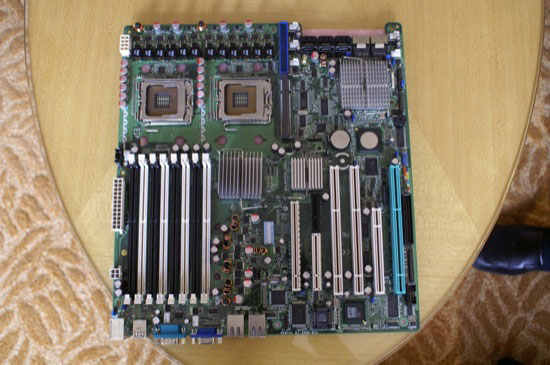 |
| Click to enlarge |
The standard Blackford chipset features a quad channel FB-DIMM memory controller; each white FB-DIMM slot below indicates a separate memory channel:
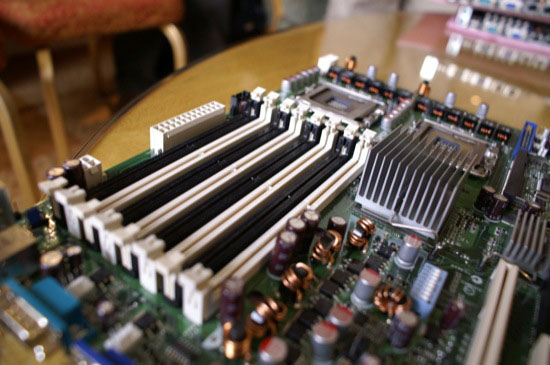
ASUS also has a version of this motherboard based on the Blackford-VS chipset, which only supports two FB-DIMM channels:
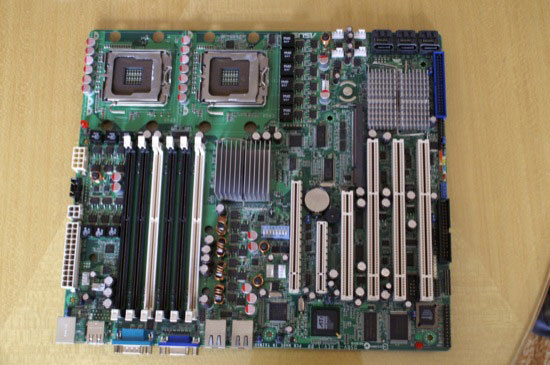 |
| Click to enlarge |
Later this week we will have our own review of Intel's Blackford chipset running Woodcrest, a platform that was officially announced late last month.
Before concluding its presentation, ASUS' server division introduced us to a very clean 1U server based on a Blackford-VS motherboard:
The server is very clean on the inside and features dual redundant power supplies, as well as a completely tool-less design.
There are three LAN ports on the back of the chassis (the one at the right is covered in this picture); the third port is for remote system management, which is very helpful in any enterprise environment.
The LED to the left of the VGA connector illuminates when the server fails so it is easy to pick out when installed in a rack of tens of these servers.
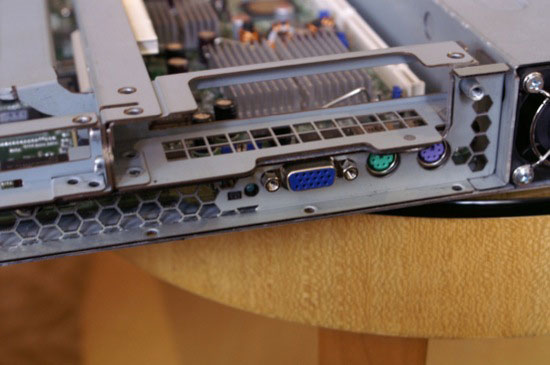
The cooling fans in the server are all easily removable should there be a failure:
There are four hot swappable drive bays at the front of the chassis, all of which support either a SAS or SATA drive.
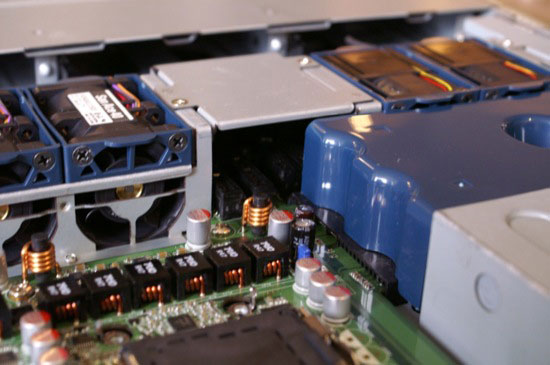


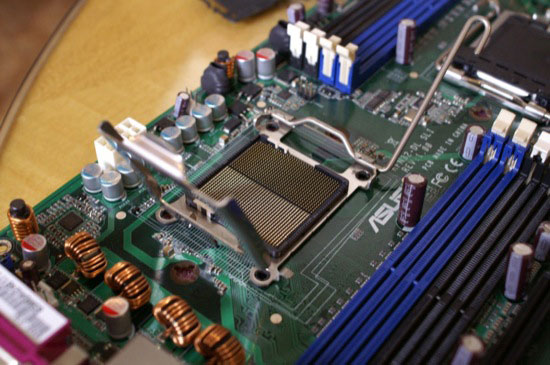

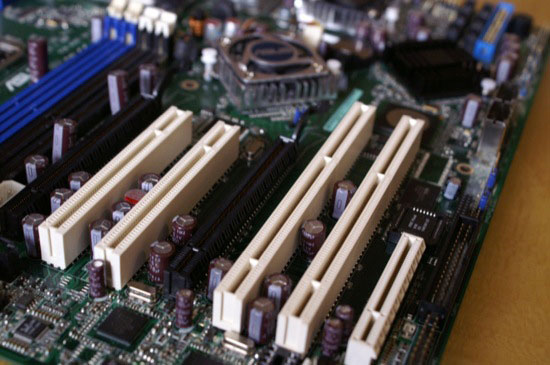
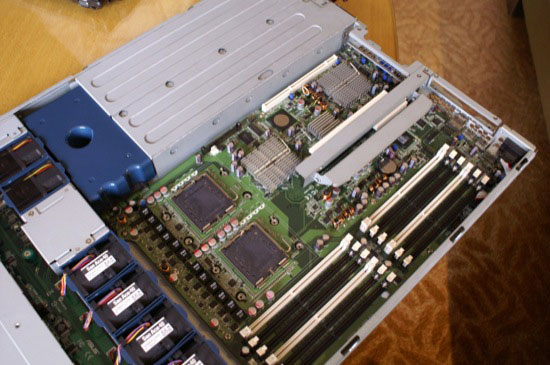

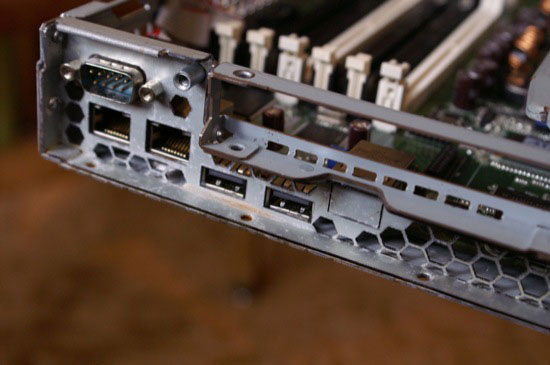
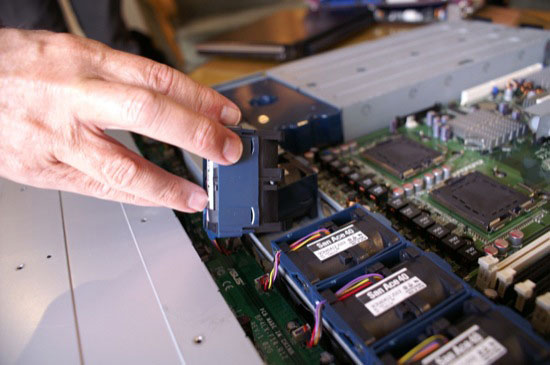








61 Comments
View All Comments
ceefka - Tuesday, June 6, 2006 - link
Just when Intel has attractive numbers on power consumption and also AMD aims again for lower numbers these GPUs negate all their effort and have you on the look out for an even bigger PSU or an additional PSU. How can ATI or NVIDIA justify this? I'd like a good reason.phusg - Tuesday, June 6, 2006 - link
I think you've already given the only reason (CPU's using less). I won't call it a 'good' reason, but all the same.sri2000 - Tuesday, June 6, 2006 - link
When I read that line about 1000-1200 watt PSU's, all I could think of was Doc Brown in Back to the Future yelling "1.21 Gigawatts!?!"... (yeah I know - kilowatt != gigawatt... but still).Griswold - Tuesday, June 6, 2006 - link
Who knows, maybe ATI/Nvidia bundle plutonium batteries (as seen in deep space probes) with their cards in the future? Not only to feed the cards but mainly to power your cooling equipment...segagenesis - Tuesday, June 6, 2006 - link
Exactly my first thought. The concept of a seperate external supply for a graphics card is already ludicrous to me, if this becomes standard then I would hate to see future progression from there. Does anyone remember the Taco Town SNL skit? I desire better video as much as anyone else, but I draw the line when I need a nuclear power station to run it. ATI/nVidia must have forgotten that electricity DOES cost money.Needless to say... impressive Conroe boards, for a premium.
Stele - Tuesday, June 6, 2006 - link
All in all an excellent article, good coverage and of course lovely photos :PThe Asus Pluto board is interesting indeed, especially the audio riser card. By the way, anyone noticed that the riser card is nicknamed Charon? For the uninitiated, Pluto was the Greek god of the Underworld, separated from the living world by the river Styx. Charon was the boatman who ferried the dead across that river to Pluto's domain. The two have hence been generally closely associated with one another. In astronomy, Pluto's moon is also named Charon, for the same reason. Nice bit of humour on Asus' side :P
punko - Tuesday, June 6, 2006 - link
Actually, Pluto is the Roman name for the Greek God Hades. Charon was indeed the ferryman of the Underworld, but the river wasn't Styx, but Acheron. I believe that there were four famous rivers in the Underworld, Lethe was another, but I can't remember the fourth.Stele - Tuesday, June 6, 2006 - link
It is another Greek name for Hades (from Greek ????t??, Plouton), but it was adopted by and hence much more commonly associated with Roman mythology.
Oh heh! Styx was the popular misconception... forgot about it. Thanks for correcting me! There were five rivers of Hades: Acheron (the river of sorrow), Cocytus (lamentation), Phlegethon (fire), Styx (hate) and... Lethe (forgetfulness). I guess that explains why you remember Lethe but forgot the others! ;)
DigitalFreak - Tuesday, June 6, 2006 - link
Didn't really see anything new here.Audio on a riser card - DFI has been doing it for awhile now.
Lighting around the I/O shield - Been done before.
Debug code readout - Been on numerous boards for quite some time. Asus just made it viewable from outside the case.
Stele - Tuesday, June 6, 2006 - link
No, I wasn't saying that anything was new in the industry, but new at least to Asus. IMHO the concept motherboard was an interesting exhibit, even if it isn't the only one of its kind.More to the point, what's noteworthy is that Asus - along with other manufacturers as well, hopefully - is considering following DFI's Karajan module concept. That can only be a good thing, as long as the manufacturers sincerely mean to improve noise immunity and not just throw it in as a gimmick to charge a premium for.
As for the other ideas... interesting but not terribly unique, as you've already pointed out.